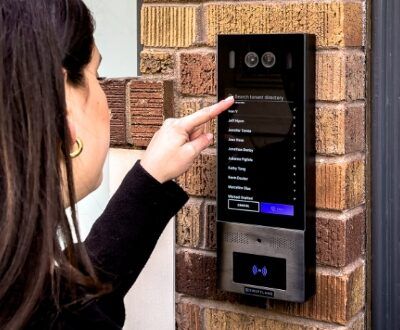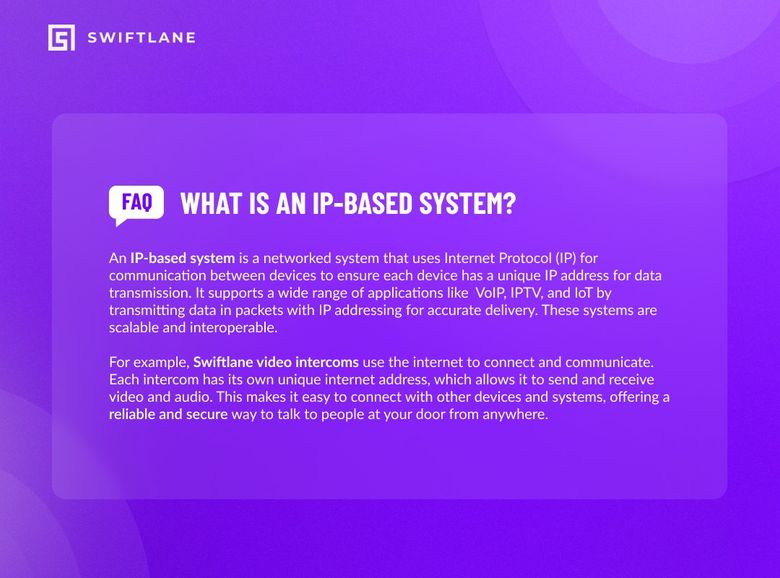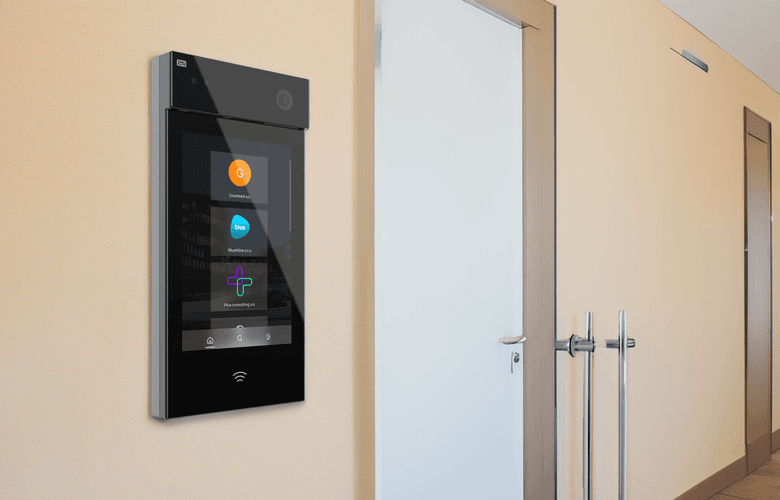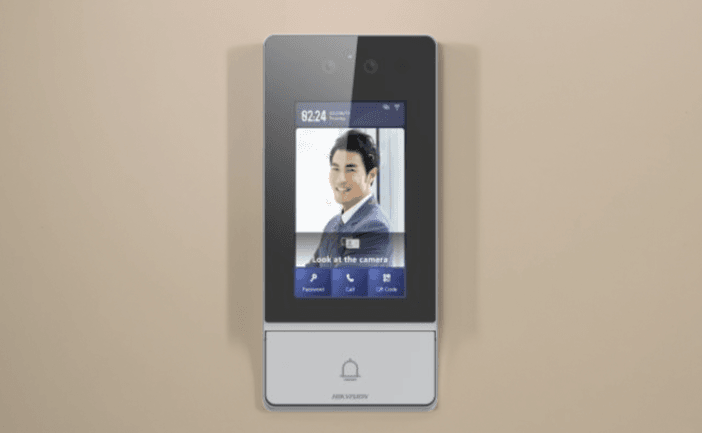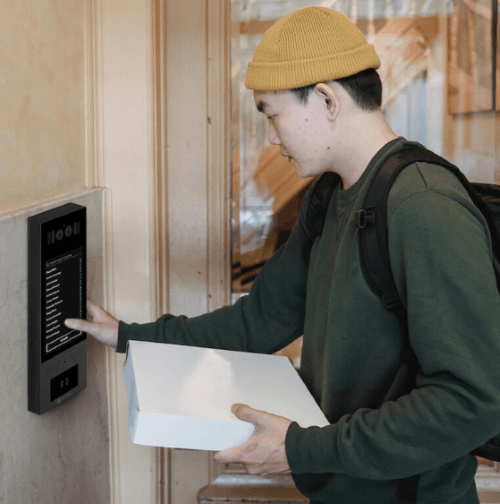Security and communication are top priorities for property owners and managers. Traditional intercom systems have evolved, and now, IP intercom systems provide advanced, cloud-based solutions with video capabilities, remote access, and seamless integration with smartphones.
But is an IP intercom system the right choice for your property? In this article, we explore what an IP intercom system is, its applications, and how it benefits property owners, managers, and tenants alike.
Table of Contents
- What Is an IP Intercom?
- Benefits of IP Intercoms Over Traditional Intercoms
- Use Cases for IP Intercom Systems
- Benefits for Property Owners, Managers, and Tenants
- In Summary: Buildings Benefit from IP Intercom Installations
- Best IP Intercom Systems
What Is an IP Intercom?
An IP intercom (Internet Protocol intercom) is a modern communication system that uses Internet networks to enable voice and video communication between different locations. Unlike traditional intercoms that rely on telephone networks or dedicated analog wiring, IP intercoms connect to the Internet using Ethernet, cellular data networks, or Wi-Fi, allowing for remote access, integration with smart systems, and advanced security features.
Most significantly, Internet Protocol lets these modern intercoms connect over the Internet to users’ smartphones. That way, building tenants can open the door with their smartphones and take visitor intercom calls from anywhere – a feature called mobile access control. Nearly all IP intercoms are paired with a dedicated mobile app, a key component of the IP intercom system.
There are different types of IP intercom systems, including:
- IP Video Intercom Systems – These provide live video communication, allowing users to visually verify visitors before granting access.
- IP Audio Intercom Systems – These offer voice-only communication over a network.
- Cloud-Based IP Intercom Systems – These systems allow remote access from anywhere via mobile applications, making them ideal for multi-tenant buildings and property managers.
The best IP intercoms integrate all three capabilities in the same device.
How Does an IP Intercom Work?
- Network Connection: The intercom connects to an existing IP network via Ethernet, cellular data networks (such as LTE or 5G), or Wi-Fi.
- Digital Signal Transmission: Voice, video, and data signals are converted into digital packets and transmitted over the network.
- Access Control & Communication: Building tenants can communicate with guests at the intercom using a smartphone, tablet, computer, or dedicated monitor.
- Remote Management: Authorized users can manage access remotely via cloud-based apps or software.
Common Features of IP Intercom Systems
- High-Quality Audio & Video: HD voice and video communication with noise cancellation.
- Remote Access & Control: Manage access through mobile apps or web interfaces.
- Integration with Security Systems: Works with CCTV cameras, alarms, and door locks.
- Cloud Storage & Recording: Stores audio and video logs for security.
- Multi-Site Connectivity: Connects multiple locations through a single network.
- Door Entry & Access Control: Can unlock doors remotely via RFID, PIN codes, or facial recognition.
- Interoperability: Integrates with smart home and business automation systems.
Benefits of IP Intercoms Over Traditional Intercoms
Clearer Communication
IP intercoms provide high-quality digital voice and video, eliminating the muffled audio and static common in traditional systems. This ensures smooth, real-time communication, whether across a building or remotely.
Remote Access & Convenience
Unlike traditional intercoms that require physical presence, IP intercoms let users answer calls and grant access via smartphones, tablets, or computers from anywhere. This is ideal for homeowners and businesses managing entry remotely. Especially for residential buildings, it helps tenants and condo owners manage the high volume of deliveries and service workers common today without the building requiring a front desk.
Scalability & Easy Expansion
Traditional intercoms require extensive wiring for additional units, making expansion costly and complex. IP intercoms integrate seamlessly into existing Internet networks, allowing for easy scaling across multiple locations.
Enhanced Security & Monitoring
With encrypted communication, access logs, and real-time monitoring, IP intercoms provide superior security. Users can track visitors, store recordings, and integrate with surveillance systems for comprehensive protection. With video capabilities similar to IP intercoms, users can also identify who is at the door, which helps deter package thieves.
Smart System Integration
IP intercoms work with smart locks, security cameras, and automation platforms, creating a fully connected security network. This interoperability streamlines access control and enhances overall efficiency.
Cost-Effectiveness Over Time
While traditional systems require frequent maintenance and rewiring, IP intercoms reduce long-term costs by using existing networks and minimizing upkeep. Their many features can also serve as a virtual concierge or doorman for the building, keeping operating costs down.
Cloud-Based Storage & Management
Unlike older systems with limited or no logging, IP intercoms store audio and video records in the cloud, making it easy to retrieve past interactions for security and documentation.
A Modern Solution for Security & Efficiency
Switching to IP intercoms means upgrading to a system that is more reliable, flexible, and future-proof. Whether for homes, businesses, or industrial facilities, IP intercoms offer smarter security and seamless communication.
Use Cases for IP Intercom Systems
IP intercom systems are widely used in various applications, including:
Residential Buildings
- Apartment complexes and condominiums benefit from IP-based intercom systems for apartments, which allow residents to see and communicate with visitors remotely.
- Multi-tenant buildings can integrate the best IP intercom system to provide secure and seamless entry management.
- Cloud-based systems eliminate the need for physical keys or in-unit intercom hardware.
Commercial Properties
- Office buildings and co-working spaces use IP video intercom systems to verify guests and delivery personnel.
- Access control integration ensures that only authorized personnel can enter restricted areas.
- Businesses can manage entry remotely, improving efficiency and security.
Industrial and Gated Facilities
- Warehouses and manufacturing facilities use IP intercoms to manage gate access and internal communication.
- Gated communities can leverage IP intercoms to provide secure visitor management and convenient resident access.
Benefits for Property Owners, Managers, and Tenants
Building Owners:
- Enhanced Security – Reduce unauthorized entry and improve property safety with real-time video and access logs.
- Increased Property Value – A modern IP intercom system adds value to rental and commercial properties.
- Cost-Effective Solution – Cloud-based systems reduce installation and maintenance costs compared to traditional wired intercoms.
Property Managers:
- Remote Access Management – Monitor and control building entry from anywhere using a mobile app.
- Seamless Integration – IP intercoms can connect with access control systems, security cameras, and smart home devices.
- Scalability – Easily expand the system as new tenants move in or additional security features are needed.
Tenants:
- Convenient Visitor Management – Residents can grant access remotely without needing to be home. Provide access to deliveries, house guests, child and pet care, and house cleaners.
- Improved Safety – Video verification allows tenants to screen visitors before opening doors. This deters unauthorized entries and “porch piracy” – another name for package theft.
- Smartphone Compatibility – IP intercom apps provide instant alerts and access control at the tap of a button.
In Summary: Buildings Benefit from IP Intercom Installations
An IP intercom system offers a modern, efficient, and secure solution for managing property access. Whether for residential apartments, commercial offices, or industrial facilities, an IP-based intercom system for apartments and businesses enhances security and convenience for all users.
Investing in the best IP intercom system can provide long-term benefits by streamlining entry management, improving property value, and ensuring tenant satisfaction.
Are you considering upgrading your building’s intercom system? Compare available solutions and find the right IP intercom for your property today.
Best IP Intercom Systems
We examined four popular and well-regarded IP intercoms. We provide a breakdown of their features, who they are good for, and potential pros and cons based on our extensive research.
Best for Office Buildings: 2N IP Style
Manufacturer: 2N (A Part of Axis Communications, Czech Republic)
Screen Size: 10-inch touchscreen
Connectivity: Ethernet (PoE), Wi-Fi
Mobile App: My2N App (iOS 4.5-star rating & Android 3.2-star rating)
The 2N IP Style is a high-end smart intercom for luxury residential, commercial, and corporate environments. It features a large 10-inch capacitive touchscreen, making it one of the most visually impressive intercom systems on the market.
This model includes AI-powered facial recognition, RFID access, PIN authentication, and mobile app integration, offering multiple secure entry methods. It is IP65 and IK08-rated, making it weather-resistant and durable for outdoor installations.
The 2N Mobile Video App enables remote access, allowing users to answer video calls, unlock doors, and monitor visitors from anywhere. Thanks to its SIP-based VoIP support, it integrates seamlessly with business communication systems and security platforms like Milestone, Genetec, and Axis VMS.
With its ultra-wide-angle Full HD camera, HDR technology, and low-light performance, the 2N IP Style delivers exceptional video quality for security-conscious installations.
Pros
- 10-inch high-resolution touchscreen – one of the largest in the industry
- AI-powered facial recognition & multiple authentication options
- Ultra-wide-angle Full HD camera with HDR & night vision
- Durable, vandal-resistant (IK08) and weatherproof (IP65)
- Cloud-based mobile access via 2N Mobile Video App
- Seamless integration with access control and security platforms
Cons
- Premium price point – Typically priced over $4,000, it’s more expensive than most competitors.
- Facial recognition setup requires initial configuration.
Best For: Luxury residences, high-security commercial buildings, and corporate offices requiring premium video intercom solutions.
Best for Retail and Mixed Use: Commend OD10 TD CM
Manufacturer: Commend (Austria)
Screen Size: 10-inch touchscreen
Connectivity: Ethernet (PoE)
Mobile App: Commend Mobile Client (iOS 4.5-star rating & Android no rating)
The Commend OD10 TD CM is a high-end, industrial-grade smart intercom designed for critical infrastructure, high-security environments, and commercial buildings. It features a 10-inch capacitive touchscreen, offering a modern user experience with intuitive navigation. Options range from creating custom menus to integrating interactive on-screen elements, such as video feeds or advertising modes —a feature that retailers and client-facing businesses oftenseek.
This model features moderate durability (IK07-rated vandal resistance) and an IP65-rated weatherproof enclosure. It provides crystal-clear, full-duplex audio with active noise cancellation, ensuring reliable communication in noisy areas such as industrial sites, airports, and corporate campuses.
The OD10 TD CM integrates seamlessly with SIP-based VoIP communication systems, allowing easy connection to corporate security networks, emergency response centers, and access control platforms. It also supports remote access via the Commend Mobile Client, enabling video calls, visitor verification, and door unlocking from a smartphone.
Its camera is optimized for low-light performance, and it includes motion detection capabilities, making it a strong security tool for real-time monitoring.
Pros
- A 10-inch touchscreen with a responsive, intuitive UI
- IK08 vandal resistance & IP65 weatherproofing for extreme durability
- Advanced noise cancellation & crystal-clear full-duplex audio
- SIP-based VoIP integration for seamless communication
- Commend Mobile Client for remote video calls & access control
Cons
- Premium price point—designed for high-security applications
- No built-in facial recognition (PIN & RFID-based authentication only)
Best for: High-security locations, industrial sites, airports, and corporate facilities that need a rugged, touchscreen smart intercom.
Best for Tight Budgets: Hikvision DS-KD96330-WBE6
Manufacturer: Hikvision (China)
Screen Size: 10.1-inch touchscreen
Connectivity: Ethernet (PoE), Wi-Fi
Mobile App: Hik-Connect App (iOS 4.7-star rating & Android 4.8-star rating)
The Hikvision DS-KD96330-WBE6 is a high-performance, modular smart intercom designed for multi-tenant buildings, commercial properties, and high-security environments. It features a large 10.1-inch capacitive touchscreen, making it one of the biggest displays in a video intercom system.
This model has multiple authentication options, including facial recognition, fingerprint scanning, RFID cards, PIN codes, and mobile credentials via the Hik-Connect App. The integrated AI-powered facial recognition enhances security by providing fast and accurate identification.
The top-tier camera system features HDR imaging, ultra-wide-angle viewing, and excellent low-light performance, making it an ideal choice for real-time security monitoring. It seamlessly integrates with Hikvision CCTV, NVRs, and access control systems, allowing centralized management.
With SIP-based VoIP support, the DS-KD96330-WBE6 can connect to VoIP phone systems for remote communication, while the Hik-Connect App enables mobile access, remote unlocking, and visitor logs.
Pros
- 10.1-inch touchscreen – One of the largest intercom displays available
- Multiple authentication options – Facial recognition, fingerprint, RFID, PIN, and mobile access
- HDR and wide-angle camera – Superior video quality in various lighting conditions
- Seamless integration with Hikvision security cameras and access control
- Value Pricing – It’s available for around $1,200
Cons
- Best suited for buildings already using Hikvision security systems
- Complex setup—requires professional installation for optimal performance
- Tech support is handled from China, with no live 24/7 support option
Best for: Multi-tenant buildings, commercial offices, and high-security environments that need a large touchscreen with AI-powered authentication and deep security integration.
Best for Residential Buildings: Swiftlane SwiftReader X
Manufacturer: Swiftlane (United States)
Screen Size: 8-inch IPS LCD touchscreen
Connectivity: Ethernet (PoE)
Mobile App: Swiftlane App (iOS 4.8-star rating & Android 4.8-star rating)
The Swiftlane SwiftReader X is an AI-driven, cloud-based smart intercom and access control system designed for corporate offices, multi-tenant buildings, and high-security facilities. With its 8-inch IPS LCD touchscreen, it provides a modern, user-friendly interface for secure visitor authentication and access management.
One of its most cutting-edge features is AI-powered facial recognition, enabling completely touchless entry for employees, tenants, and visitors. It also supports mobile app access, QR codes, PIN codes, RFID keycards, and remote unlocking, offering various authentication options.
The SwiftReader X is fully cloud-based, allowing building managers to monitor visitor logs remotely, manage access permissions, and update security settings in real time via the Swiftlane dashboard. Additionally, SIP-based VoIP support enables video intercom functionality, allowing seamless two-way communication between visitors and security personnel.
With end-to-end encryption and enterprise-grade security protocols, the SwiftReader X is designed to prevent unauthorized access and data breaches. Its IK10 impact resistance is superior to most other intercoms on the market, making it the perfect intercom for urban environments where vandalism might occur. Its IP65 weatherproofing makes it suitable for both indoor and outdoor installations.
Pros
- 8-inch high-resolution touchscreen for an intuitive user experience and two-way video
- AI-powered facial recognition for touchless access
- Highest-average app rating for IP intercoms (4.8 star Android and iOS ratings)
- Multiple authentication options: mobile app, QR, PIN, RFID
- Cloud-based management for remote access control
- IK10-rated for extreme impact resistance & weatherproof for outdoor use
- Live 24/7 technical support is provided
Cons
- Requires a cloud subscription for advanced features
- Best suited for mid-to-large-scale buildings rather than small homes
Best for: Modern offices, apartment complexes, and high-security buildings that need AI-powered, cloud-based access control with a sleek video intercom interface.
Learn More: Swiftlane Swiftreader X
Get in touch with a Swiftlane specialist for more information on the best access control and video intercom solution for your building.

